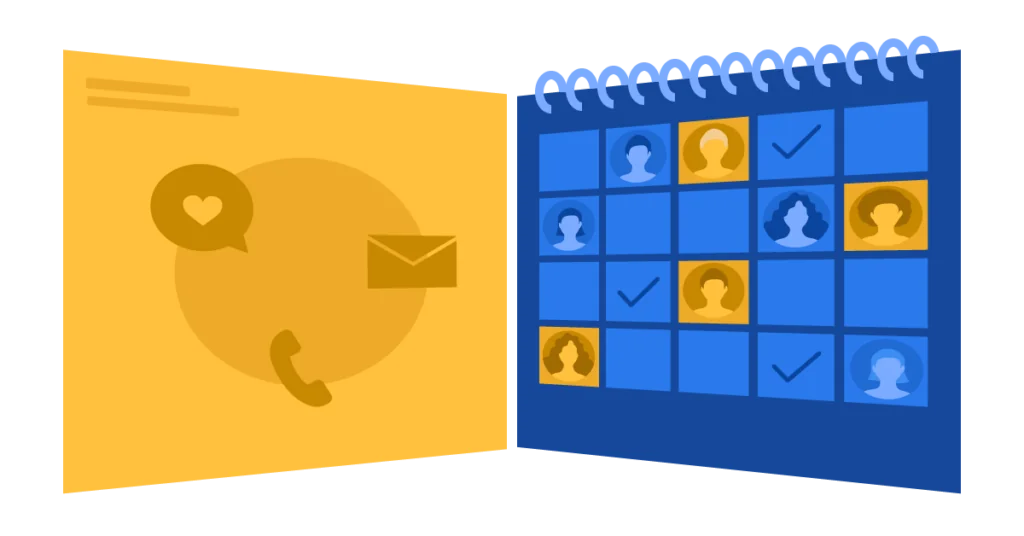5 Sales Call Cadence Best Practices That Boost Conversion Rates


Tim Edwards
This post was originally published in July 2018 and has been updated for accuracy and comprehensiveness.
One of the trickiest aspects of any sales outreach attempt is balancing persistence with professionalism. By not utilizing sales cadence best practices, you risk scorching through your database — or even missing out on key prospects.
But what is a sales cadence? Is there such a thing as a “golden sales cadence”? What other best practices should you follow?
In this chapter, we’ll dive into:
- What is a sales cadence?
- The best outbound sales cadence
- 5 best practices for a strong sales cadence

Download the Ultimate B2B Appointment Setting Guide
Don’t have time to read the whole guide right now? Download the PDF version of the guide.
What is a sales cadence?
A sales cadence is a systematic application of touches over a certain period. In the world of appointment setting, touches encompass all phone calls, voice mails, and emails left for a prospect.
At EBQ, we approach our first five touches within the sales cadence the same — regardless of their lead source. What changes for us is the timeframe between each touch point and cycle.
Later in the post, we’ll go over what factors will prolong your sales cadence.
The best outbound sales cadence
With over 87+ million dials under our belt, we can safely say we’ve developed the best outbound sales cadence that works across most industries.

You’ll notice that we didn’t specify the timeframe between each touch point. That’s because your sales cadence lifecycle is dependent on three factors:
Database size: The larger your database, the more time you can spend between each touch and cycle.
SDR team size: The smaller your database, the more touches you’ll need to make to keep your sales pipeline active.
Prospect’s temperature: Warmer leads require less cooldown time between each touch, as you want to strike while the iron is hot.

Subscribe to EBQ's Bimonthly Newsletter

Subscribe to EBQ's Bimonthly Newsletter
5 best practices for a strong sales cadence
Based on our 16+ years of experience and 4000+ completed lead generation projects, here are five key best practices for a strong sales cadence:
- Add a human touch
- Set realistic quotas
- Provide consistent training
- Perfect the handoff process
- Balance persistency and professionalism
1. Add a human touch
With the rise of AI comes the temptation to automate everything. However, there are inherent risks of relying too heavily on sales automation tools — such as making a bad first impression on key prospects.
Think about it: would you respond to a voicemail left as a canned and pre-recorded sales pitch? Or would you return a phone call after an SDR left multiple voicemails that directly addressed your pain point?
Therefore, having an SDR team prospect for you allows for more informative and valuable interactions with prospects. It fosters a stronger brand relationship, as it encourages a more open dialogue between you and your prospect.
2. Set realistic SDR quotas
One of the most common mistakes a business leader can make is not setting the right expectations. We see that many leaders would emphasize the depth of prospect relationships over the total number of appointments set.
From our experience, your SDR team should use a “miles-wise” instead of a “miles-deep” approach. Otherwise, your SDRs may lose focus on what matters most: making dials.
At EBQ, we expect our appointment setters to make at least 110 dials a day. We leave the relationship-nurturing responsibilities to the sales team. In other words, the AEs should be responsible for the remaining 75% of the sales cycle.
3. Provide consistent training
As your industry landscape changes, so will your sales development process. That’s why you should never treat your SDR playbook as a static document; it should routinely get updated as you discover new talk tracks and develop new strategies.
Our SDRs receive two weekly training sessions at EBQ — regardless of their current performance: a team huddle and a shadowing session.
Weekly team huddles empower your team to regularly share their insight. You can discuss what soundbites have been performing exceptionally well, and even discuss the quality of your current database.
Meanwhile, the 1×1 shadowing session allows managers to sit in SDR calls and provide real-time feedback. Then, the SDR has the opportunity to listen to their manager’s cold calls to learn applicable tips.
At the end of the day, providing a strong SDR training program empowers your SDRs to sharpen their skills to make each touch point count.
4. Perfecting the handoff process
A strong sales cadence means nothing if you don’t master the handoff process. A warm handoff process is when a prospect is introduced to a salesperson by the SDR (i.e. the person they are already familiar with).
As mentioned in Chapter 3, an SDR should only set appointments for their designated salesperson. Therefore, make sure the SDR always has access to the salesperson’s calendar. That way, the SDRs can easily block time on the salesperson’s calendar during their phone call with a prospect.
Balance persistency with professionalism
More often than not, we see salespeople giving up too early after just one rejection. However, studies show that the average B2B buyer says “no” four times before they commit to a solution.
That said, too aggressive of a touch cadence will increase signs of friction — such as unsubscribing to your emails or even neglecting your calls. In fact, we recommend relegating a contact after five initial touches. Otherwise, you risk ruining your brand reputation by coming across as disrespectful to your prospect’s boundaries.
Then, rinse and repeat the sales cadence after 3, 6, or 12 months. Your timeframe will depend on several factors, such as:
- Database size
- SDR team size
- Industry type
- Prospect’s temperature

Download the Ultimate B2B Appointment Setting Guide
Don’t have time to read the whole guide right now? Download the PDF version of the guide.
Perfecting your sales cadence
By following EBQ’s touch cadence, you’ll be able to strike a balance between being persistent and protecting your brand reputation. Our five best practices to perfect your sales cadence are:
- Add a human touch
- Set realistic quotas
- Provide consistent training
- Perfect the handoff process
- Balance persistency and professionalism
That said, your sales cadence is only as strong as your SDR team. If you need help setting appointments with decision-makers, consider partnering with EBQ. With over 16+ years of experience within the appointment-setting industry, we understand how to chase down leads with the least amount of friction.
